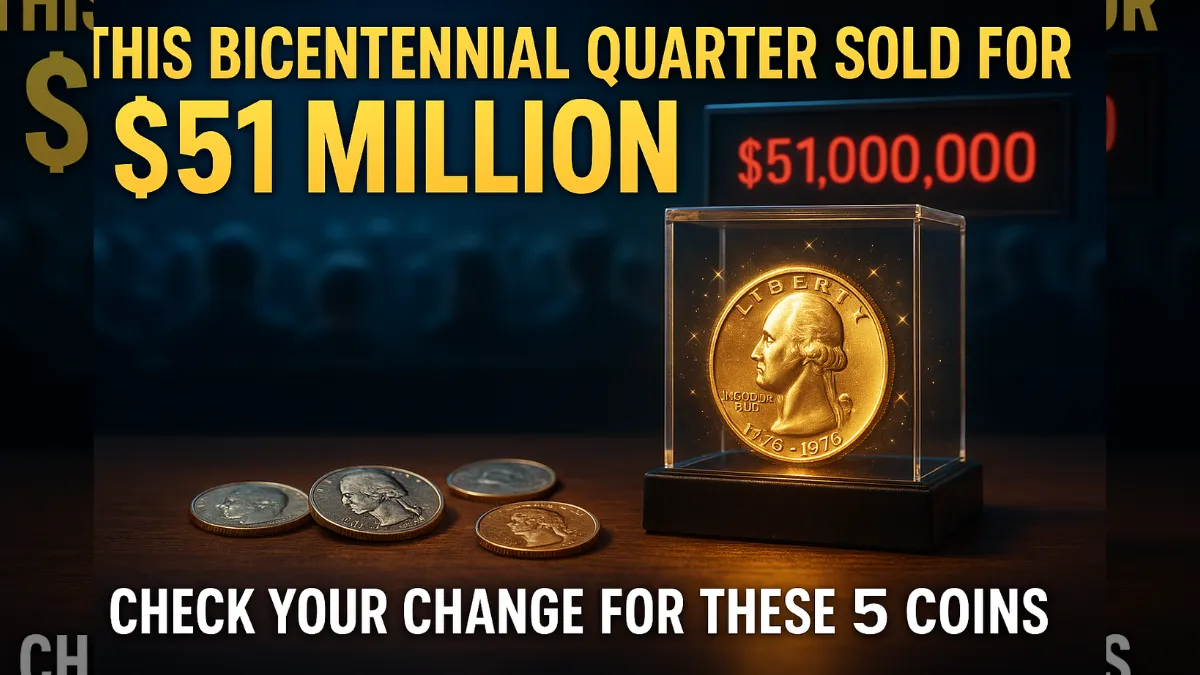Is There Really a Bicentennial Quarter Worth $51 Million? Here’s the Truth, Plus 5 Real U.S. Coins That Are Worth a Fortune
The world of coin collecting is filled with fascinating stories, and recently, one has made waves across the internet: a 1976 Bicentennial Quarter supposedly worth $51 million. Sounds incredible, right? That’s because it is—mostly fiction.
While it’s unlikely that any Bicentennial Quarter has fetched such a sky-high price, there are U.S. coins out there that truly are worth millions.
This guide will break down the facts about the rumored $51 million quarter, highlight five truly valuable American coins, and teach you how to identify rare coins in your own collection.
The Real Story Behind the $51 Million Bicentennial Quarter
The 1976 Bicentennial Quarter was released to honor 200 years of American independence, showcasing a unique design with a colonial drummer and the dates 1776–1976. While many of these quarters were minted and are still common today, some rare error coins exist that can fetch higher prices.
But has any of them sold for $51 million? Not at all. This figure appears to come from exaggerated claims, viral articles, or speculative appraisals with no actual proof from official auctions or credible sales records.
That said, certain error versions of the Bicentennial Quarter can be worth significant amounts. Variants with double die errors, off-center strikes, or those minted on silver planchets can be valued from hundreds to thousands of dollars depending on rarity and condition.
Features That Can Make a Bicentennial Quarter Valuable:
- Minted on 40% silver planchets (intended for special collector sets)
- Double die errors on either side
- Struck off-center
- High mint-state grades (MS67 or higher)
5 Rare U.S. Coins That Are Actually Worth Millions
While the $51 million Bicentennial Quarter is likely a myth, here are five American coins that have proven their worth at legitimate auctions:
1. 1913 Liberty Head Nickel
- Rarity: Only five known to exist
- Value: One sold for $3.7 million in 2010
- Backstory: These coins were never officially released for circulation, making them legendary among collectors.
2. 1943 Bronze Lincoln Cent
- Known Examples: Between 10 and 15
- Auction Price: As high as $336,000
- Why It’s Valuable: During WWII, pennies were supposed to be made from steel. Some were mistakenly struck in bronze.
- How to Check: Use a magnet. Steel coins stick—bronze doesn’t.
3. 1933 Saint-Gaudens Double Eagle
- Rarity: Only 13 are known
- Value: A specimen sold for $18.9 million in 2021 at Sotheby’s
- Why Collectors Love It: Often called the most beautiful coin ever minted in the U.S.
4. 1894-S Barber Dime
- Minted: Just 24, with 9 surviving
- Auction Value: One sold for $1.9 million in 2007
- Interesting Fact: Believed to have been made for bankers’ children as gifts.
5. 1787 Brasher Doubloon
- Estimated Value: $9.36 million in a 2021 sale
- Significance: Minted by goldsmith Ephraim Brasher before the U.S. Mint existed, making it a cornerstone of early American coinage.
How to Identify a Rare or Valuable Coin
You don’t need to be a seasoned collector to spot potentially valuable coins. Here are some practical tips to help you identify rare finds:
1. Check the Date and Mint Mark
Dates and mint marks (like “S” for San Francisco or “D” for Denver) are crucial. For example, a 1909-S VDB Lincoln Cent is worth over $1,000 in good shape.
2. Look for Mint Errors
Certain errors can significantly boost a coin’s value, such as:
- Double die errors
- Off-center strikes
- Coins struck on the wrong metal planchet
3. Examine the Condition
Coins are rated on a 70-point scale. Higher-grade coins are much more valuable:
- MS60–MS70: Mint State (uncirculated)
- AU: Almost Uncirculated
- VF: Very Fine
4. Use Reliable Resources
For accurate appraisals and pricing, use trusted tools and databases like:
- PCGS CoinFacts
- NGC Price Guide
- Heritage Auctions records
Getting Your Coins Professionally Appraised
Think you’ve found a rare gem? Here’s how to get a trustworthy evaluation:
- Skip basic pawn shops unless they have numismatic experience.
- Send coins to PCGS or NGC for official grading and certification.
- Contact a local ANA-certified dealer or visit a coin show.
- Most grading services offer insured shipping and high-quality photographs of your coin.
FAQs About Rare Coins and Collecting
Q: Is there a Bicentennial Quarter worth $51 million?
A: No credible sales support that claim. However, error versions can fetch hundreds or thousands of dollars depending on their characteristics.
Q: How do I know if my coin is rare?
A: Start by checking the year, mint mark, and any visible anomalies. Use trusted online databases for comparisons.
Q: Are valuable coins still found in circulation?
A: Yes! Older coins, especially from the early 1900s or with mint errors, occasionally turn up in everyday pocket change.
Q: Should I clean my coins before sending them in?
A: Never. Cleaning a coin can ruin its natural finish (patina) and drastically lower its value.
Final Thoughts
While the $51 million Bicentennial Quarter is more fantasy than fact, the coin collecting world still holds incredible treasures.
From the historic 1933 Double Eagle to rare Lincoln cents, knowing what to look for is your best tool in uncovering value. Armed with expert-backed resources and a careful eye, you might just stumble upon a piece of history in your spare change.
